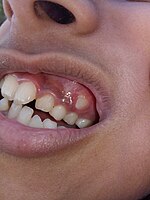
Photo from wikipedia
OBJECTIVE To determine the relationship between AOB and factors such as dental arch dimensions and tongue position during swallowing and phonation. MATERIAL AND METHODS A case-control study was performed in… Click to show full abstract
OBJECTIVE To determine the relationship between AOB and factors such as dental arch dimensions and tongue position during swallowing and phonation. MATERIAL AND METHODS A case-control study was performed in two groups: 132 children with Anterior Open Bite (AOB) and 132 with normal vertical overbite (NVO), aged 8-16 years selected from the records taken by a previous study from five public schools. Dental arch dimensions were assessed through digitalized study models. Swallowing was evaluated using the Payne technique, and phoniatric assessment included an adaptation of the articulation test used to describe phonemes. STATISTICAL ANALYSIS Chi-Square or Fisher's exact test for comparisons between qualitative variables and the Mann Whitney or T-student were applied to compare the dental arch dimensions according to bite type. A logistic regression model was applied to control the effect of confusion between independent variables and to describe its simultaneous effect on the type of bite. RESULTS Intercanine, interpremolar and intermolar widths showed higher values in AOB patients with a mean deviation (MD) of 0.536 (P=0.031), 0.60 (P=0.043) and 1.15, (P<0.001) respectively. Distortions caused by tongue interposition and thrust, tongue protrusion during swallowing, mandibular arch intermolar width, total maxillary arch length, maxillary arch perimeter, and posterior arch depth accounted for 64.6% of AOB and allowed for correct predictions in 83.8% of the cases observed in the study population. CONCLUSIONS A significant association between tongue position and function, as well as alterations such as tongue interposition and thrust during swallowing and phonation in individuals with AOB, were observed. There is a relationship between AOB and the presence of a wider mandibular arch and a narrower, longer, and deeper maxillary arch.
Journal Title: International orthodontics
Year Published: 2021
Link to full text (if available)
Share on Social Media: Sign Up to like & get
recommendations!